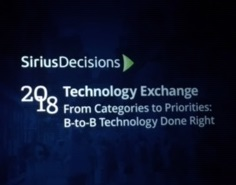Imagine that you’re a year into a role as a sales or marketing ops manager for a medium-to-large B2B business, and that you have a CRM at the core of your stack. A CRM, what’s more, which became popular before the turn of the millenium. A CRM your sales team hates. You know there are some cool sales enablement solutions available, and whether they have a snowball’s chance in Arizona of integrating with the CRM you have no idea.
So your boss sends you along to SiriusDecisions Tech Exchange to at least start to figure out how to approach that kind of challenge.
That’s a real story for the event currently unfolding in a humid New Orleans; name and affiliation of attendee withheld for obvious reasons, although when I tell the story, people have been good at guessing the CRM in question.
If the audience is leans somewhat towards hands-on professionals, getting Lab training in putting together matrices like the SiriusDecisions “Tech Stack on a Page,” there are also senior level attendees, as Jonathan Tam, senior research director at SiriusDecisions, told me. “A lot of SVPs and VPs here, just trying to make those key business decisions. As technology bubbles up as a priority, it makes sense for them to get an understanding of what’s going on.”
But surely the case I described is a no-brainer: buy a new CRM. It’s not that simple, said Tam. “Either organizations have been saddled with old technology, or they don’t even understand what technology they have.” People think, “Let me go replace my legacy CRM with a new CRM; and that may solve some issues, but in two years it’s the same challenges. Especially with all the new technologies coming up. People are given a budget and told ‘go fix technology.’ They go buy this, this, and this, then they run into adoption challenges.”
That’s why SiriusDecisions analysts flip the question, “What technology should I buy?” The first question, said Tam, should be “What are you going to do with it?”
Given that context, I asked Tam what the leading concerns of Tech Exchange attendees seemed to be. Top of his list was how to integrate technologies, and how to use it for its intended purpose. “That’s the scary part,” he told me, “to take a step back and say ‘what’s my strategy?'” That doesn’t, of course, mean having a pre-existing strategy and shopping for technology to fit it. “We need to make sure technology is part of that initial strategy conversation.”
I put a similar question to Nani Shaffer, director of product marketing at leading ABM provider Demandbase. Shaffer had just given a presentation on programmatic advertising and attribution in an ABM context, topics I reviewed back in September with Demandbase CMO Peter Isaacson. Her response was consistent with Tam’s.
“Aside from the giant elephant in the room of privacy, the other challenge we’re seeing a lot is people trying to connect systems — how to create that seamless experience you’re looking for. In my past experience in marketing ops, John wants one solution and has his justification. Mary wants another. The marketing ops manager has to say, ‘Wait, they seem a little similar; are they redundant technologies, or complementary technologies? It’s really tough to be in those shoes, figuring out what’s real, and which solutions work together.”
Another complex challenge is the multiplicity of journeys customer are taking from initial interest to conversion. “No journey is the same. I would try and piece it together; in one account you can kind of do it — 62 touchpoints across 11 people in nine months. It’s fascinating, but not altogether helpful. Not everyone is going to go through the same thing. It’s hard to manage at scale.” Without AI, Shaffer said, “there are certain things you can do in terms of broad segmentation, but if you want to go after several thousand accounts, that’s just not manageable even for many individuals. You need the technology to do it.”
And then you add post-GDPR privacy concerns. “It’s confusing to people,” Shaffer admitted. “It’s a little bit frightening. People were concerned that their whole database would be stripped away from them.” But the positive part is that marketers need to be more creative about reaching potential buyers, even without necessarily knowing who they are.
Challenges and concerns, then, shared by what Tam calls “a very close-knit community” at Tech Exchange. “You saw the opening reception: crowded, a lot of people making new connections, that’s always exciting.”







